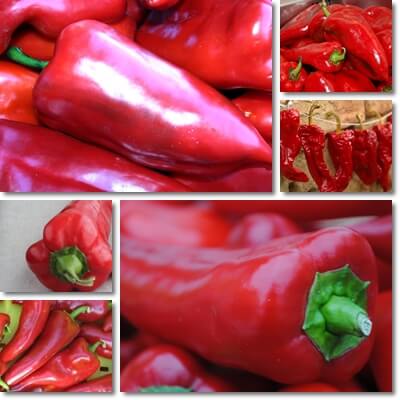Kapia peppers, also called Capia, Pepper Belcanto, Italian Corno di Torro or Bull’s Horn peppers, are known in the US plainly as Italian sweet peppers, Italian frying peppers or Red Roaster.
They are without a doubt one of the most popular types of peppers. Used for making traditional Balkan cuisine vegetable spreads such as zacusca or avjar, as well as for roasting and frying, they are a source of good nutrition and important benefits for health.
Red Kapia peppers are high in carotenoid antioxidants with vitamin A activity, while green ones are high in chlorophyll. All colors provide good amounts of B vitamins, vitamins C and K, potassium, manganese, magnesium, iron, and vitamin E in the seeds.

What are Kapia peppers?
Kapia peppers (alternative spelling: Capia) are a type of sweet pepper in the Capsicum annuum species of pepper. The Kapia pepper is related to bell peppers (also called sweet peppers) and the Round of Hungary or Romanian Gogosari peppers.
Some of you may know Kapia peppers by this very name, some of you may know them as Red Roaster peppers, Italian sweet peppers or Italian frying peppers or Pepper Belcanto, but there may very well be 50 other different names for this exact variety.
According to Wikipedia, there are an estimated 50 000 different cultivated varieties of pepper, and considering that names often differ with region, especially with less common varieties of fruits and vegetables, that alone is enough to explain why you may not know Kapia peppers as Kapia (or Capia), but by a completely different name.
What do Kapia peppers look like?
The Kapia pepper is a tapering pepper, relatively long, with a slim to bulkier, slightly flattened figure (appearance may differ depending on the cultivar). It has a thin peel and a firm and thick, but tender, crisp, succulent flesh. The peel is smooth and glossy and varies in color according to variety and degree of ripeness.
All Kapia peppers are a deep green color when unripe and, depending on cultivar, may turn deep red, a light green color and even yellow or orange when ripe. The peppers are the exact same color inside and out at all times. Interesting fact: light green Kapia peppers are called yellow Kapia or, more commonly, white Kapia (similar to white bell peppers, aka white Holland peppers).
Contrary to popular belief, the Kapia pepper includes at least a few dozen different cultivated varieties that may look more or less the same. Examples of Kapia pepper varieties: Hisarka, Delfina, Ajvarski and the very popular Elephant’s Ear or Elephant Ears Kapia which is larger, bulkier and flattened laterally (hence the name Elephant’s Ear). In terms of color, the most popular are red Kapia. Light green, aka white Kapia peppers are fairly popular stuffing peppers in Balkan countries, but always second to red.
What do Kapia peppers taste like?
A Kapia is a sweet pepper type, non-pungent and extremely flavorful. Kapia peppers are meaty peppers with a thick, but tender, crisp flesh and thin skin. The flesh is succulent and offers a fresh, juicy bite with intense sweet pepper flavors. Red Kapia peppers are the sweetest, while unripe Kapia which are a deep green color range in taste from bitter to mildly sweet with a bitter aftertaste. Red Kapia peppers tend to have the best taste of all colors which explains their popularity. It is the absolutely best pepper for salads, extremely easy to grow and resilient.

How to use Kapia peppers
Red Kapia peppers are the best salad peppers because they’re meaty, but tender, extremely sweet and succulent, with a strong and fresh peppery flavor.
Pair them with red tomatoes, yellow onions, cucumber slices and sunflower oil and season with salt for a traditional Balkan summer salad that goes great with freshly baked bread dipped in the vegetable and oil sauce.
The Kapia pepper also makes a great paprika pepper: dried and finely ground for sweet paprika, or dried, smoked and finely ground for smoked paprika.
Kapia pepper paprika can be added to meat and vegetable based dishes for a wonderful flavor.
The Romanian ‘zacusca’ (‘zakuska’ in Russian) is an absolutely delicious vegetable spread made by mixing roasted red Kapia peppers with roasted eggplant, sauteed onions and tomatoes, sometimes also grated carrot or celery root. Variants of the ‘zacusca’ exist throughout the Balkans.
You can also make traditional Bulgarian avjar from roasted and peeled, finely chopped or ground and cooked (stewed) red Kapia peppers with sunflower oil.
Kapia peppers also make an excellent roasting or frying pepper as they can be easily peeled and have fantastic flavor.
Pair the peeled pepper with a sauce made from crushed garlic cloves mixed with salt and a few tablespoons of water, or feta cheese, olives, fresh tomato and chives.
Nutrition facts and benefits Of Kapia peppers
Eating Kapia peppers is good for transit and helps relieve constipation naturally.
Red Kapia peppers are highest in red carotenoid antioxidants with vitamin A activity (beta-carotene, alpha-carotene, beta-cryptoxanthin) and provide benefits for eyesight, skin and the immune system.
Unripe green Kapia peppers are high in the antioxidant chlorophyll which helps combat oxidative stress and prevent, repair and reduce cell damage caused by free radicals.
Kapia peppers are a source of vitamin C which is good for immunity and inflammation, and boosts collagen production in the skin for better skin elasticity.
The peppers are further a good source of vitamin K for blood coagulation and contain a range of B vitamins and minerals such as potassium, magnesium, manganese and iron with tonic, energizing properties.
Kapia peppers are good for cardiovascular health, namely blood pressure and blood cholesterol. B vitamins and iron in the peppers help combat tiredness and fatigue, and muscle weakness associated with anemia.
Kapia pepper seeds are typically discarded or saved for planting the following year, but are a good source of vitamin E with antioxidant properties.
